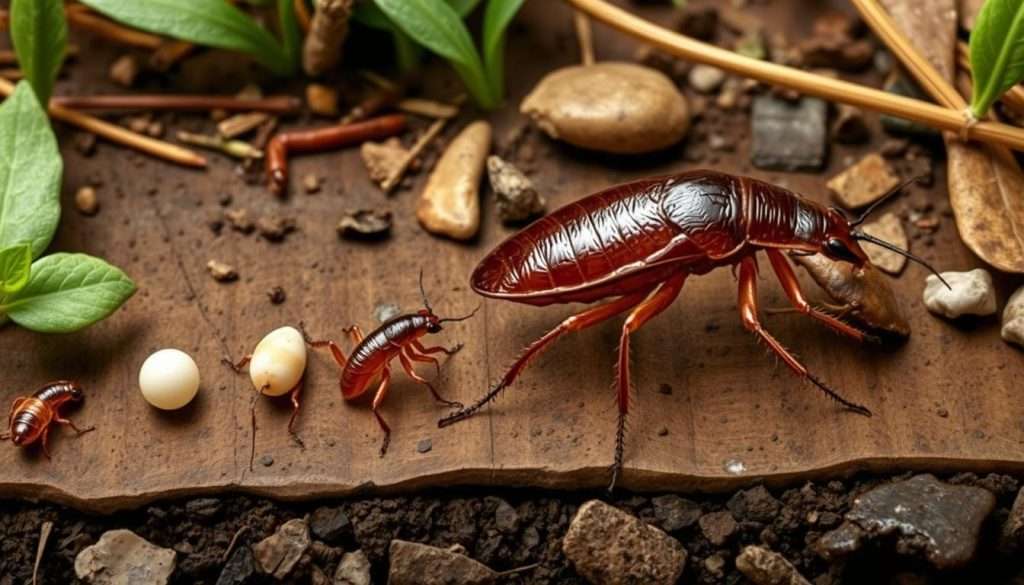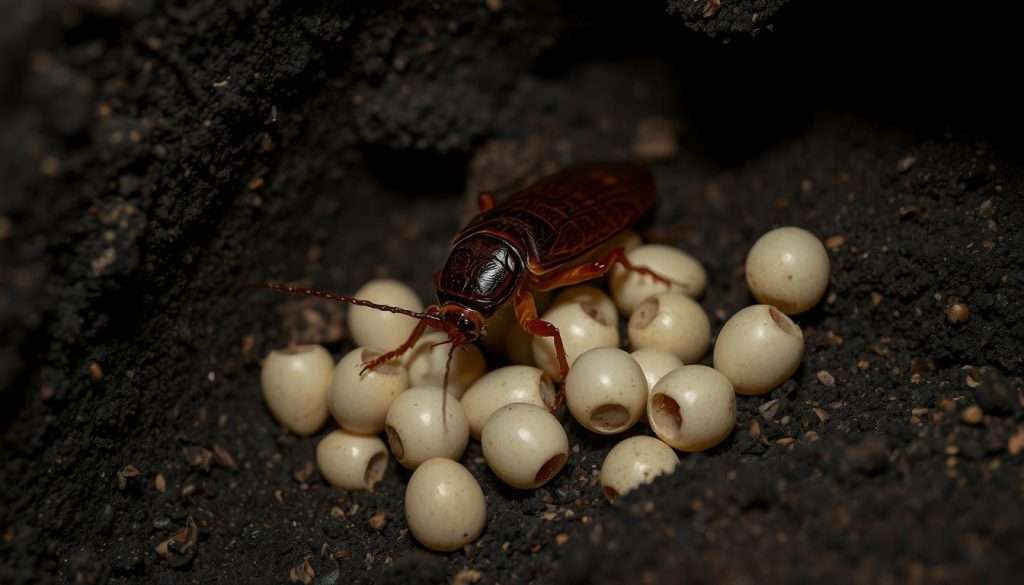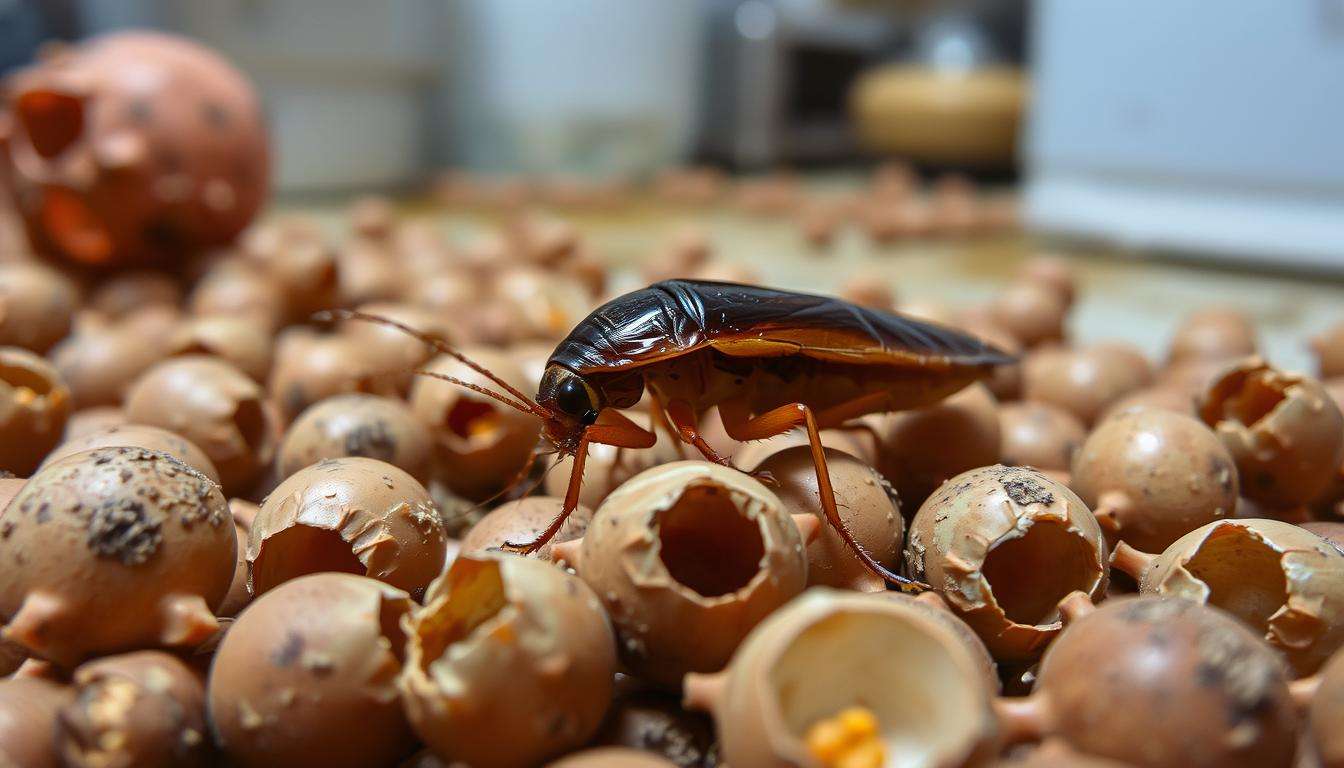Knowing how cockroaches reproduce is key for keeping your home pest-free. These insects can quickly multiply if not stopped. So, how many eggs can a cockroach lay in a day? This article dives into cockroach biology, showing how different species lay eggs and how fast they can reproduce. You’ll learn how to fight pests in your home and stop infestations before they start.
Key Takeaways
- Female American cockroaches lay about 16 eggs per ootheca, producing one ootheca per month.
- German cockroaches can carry 30 to 40 eggs in each ootheca, hatching in approximately 28 days.
- Brown-banded and Oriental cockroaches also lay around 16 eggs per ootheca, with varying incubation periods.
- Understanding cockroach reproduction is essential for implementing successful pest control strategies.
- A single cockroach can lay up to 50 eggs at a time, significantly increasing the risk of infestation.
- Identifying and addressing cockroach eggs is vital; learn more about this process here.
Understanding Cockroach Reproduction
Cockroach reproduction is key to managing infestations, especially in cities. Female cockroaches lay egg cases called oothecae. These cases hold many eggs. For example, German cockroaches have 30 to 40 eggs per ootheca, while American cockroaches have about 14 to 16 eggs.
Female American cockroaches can lay up to two oothecae a week. This means they can produce up to 90 egg capsules in their lifetime. Their high reproductive rate helps them survive despite many eggs and nymphs being eaten or dying.
To fight infestations, know the cockroach lifecycle. An egg turns into a nymph after about 55 days at room temperature. These nymphs stay in this stage for 160 to 971 days, depending on the species. Keeping areas clean is important because cockroaches love food. Sealing gaps in windows and doors helps keep them away.
Here’s a comparative overview of cockroach species and their reproduction:
| Species | Oothecae per Lifetime | Eggs per Ootheca | Gestation Period |
|---|---|---|---|
| American Cockroach | 9-10 | 14-16 | 44 days |
| German Cockroach | 4-6 | 30-40 | 28 days |
| Brown-Banded Cockroach | 10-20 | 10-18 | 50 days |
| Oriental Cockroach | ~1 per week | 16 | 2 months |
How Many Eggs Can A Cockroach Lay In A Day
Cockroaches can lay a lot of eggs, especially some types. For example, the German cockroach is very good at making babies. A female German cockroach can lay 30 to 40 eggs in one egg case every day. They can make many egg cases, leading to about 350 babies in a year.
Variations Among Cockroach Species
Each cockroach type lays eggs differently. The American cockroach lays about 16 eggs per egg case. They make one egg case a month for almost ten months. The German cockroach lays more eggs and has a shorter life.
Here’s a table showing how different cockroaches lay eggs:
| Species | Eggs per Ootheca | Oothecae Produced in Lifetime | Total Offspring |
|---|---|---|---|
| German Cockroach | 30-40 | 5-8 | Up to 350 |
| American Cockroach | 16 | 10 | Approx. 160 |
| Brown-Banded Cockroach | 16-22 | Unknown | Unknown |
| Oriental Cockroach | 16-18 | Unknown | Unknown |
Factors Influencing Egg Production
Many things affect how many eggs a cockroach lays. Temperature, humidity, and food are key. When these are right, cockroaches can quickly make a lot of babies.
High humidity and temperature help cockroaches make more babies. To stop them, we need to know these things. This helps us control pests better.
The Life Cycle of Cockroaches
Knowing how cockroaches grow is key to controlling them. They go through three main stages: egg, nymph, and adult. Each stage helps their numbers grow. This info helps homeowners fight infestations better.
Stages of Development
Let’s look at each stage closely:
- Egg Stage: It starts with the ootheca, or egg case. This protects the eggs. A single ootheca can hold 6 to 40 eggs, based on the species.
- Nymph Stage: After six to eight weeks, the eggs turn into nymphs. These young cockroaches are smaller but grow fast. They molt 6 to 14 times before becoming adults.
- Adult Stage: An adult cockroach can live 1 to 2 years. They start making babies soon after they grow up. For example, a German cockroach can lead to 300,000 more cockroaches in a year.
Impact on Infestation Risk
The life cycle of cockroaches greatly affects the risk of infestations. Knowing how fast they can multiply helps homeowners act early.
| Life Cycle Stage | Duration | Population Impact |
|---|---|---|
| Egg Stage | 6-8 weeks for hatching | Potential for rapid population growth from one egg case |
| Nymph Stage | Weeks to months, depending on conditions | Multiple molts lead to fast maturity |
| Adult Stage | 1-2 years | High reproduction rate; can produce significant offspring |

By knowing these stages, we can fight cockroaches better. This helps lower the risk from these tough pests.
Common Species of Cockroaches
Knowing the common cockroach species is key to fighting infestations. Each type has its own look and habits. It’s important for homeowners and DIY fans to know them. Here are the main traits of four common types.
German Cockroach
The German cockroach is small and brown. It has two dark stripes on its back. This cockroach breeds fast, with females making six to eight egg cases each.
Each egg case has 30–40 eggs. This means their numbers can grow quickly. Knowing how German cockroaches behave is crucial to stop them.
American Cockroach
The American cockroach is big, growing up to three to five centimeters. It’s reddish-brown in color. This cockroach loves city life and can make 10 to 30 egg capsules in its lifetime.
Each egg capsule has about 16 eggs. A female can have up to 150 babies. These pests carry diseases like diarrhea and dysentery.
Brown-Banded Cockroach
The brown-banded cockroach is known for its brown bands. It likes warm, dry places in homes. It hides in hard-to-reach spots, making it hard to find.
It may not breed as fast as others. But it’s still a threat as an urban pest. It can infest homes.
Oriental Cockroach
The oriental cockroach is dark brown to black. It likes damp places, often found in basements or near water. It’s less likely to enter homes than others.
But if it does, it means there’s a humidity problem. Keeping its habitat under control is important for a pest-free home.
Indicators of Cockroach Infestations
Spotting signs of a cockroach infestation early is crucial. It helps prevent big problems. Knowing the signs can lead to quick action.
Signs of Egg Cases
Looking for signs of egg cases is key. Oothecae, or egg cases, are a clear sign. They are brown or black and found in dark spots.
Each ootheca can hold 10 to 50 eggs. This means a fast-growing cockroach problem. Seeing these cases shows you have an infestation.
Common Hiding Spots for Cockroach Eggs
Look for cockroach eggs in warm, hidden places. They like:
- Behind appliances like refrigerators and ovens
- Under sinks in kitchens and bathrooms
- In hidden nooks within furniture
- Beneath cupboards and inside cabinets
Checking these spots helps find where they nest. This way, you can stop the problem before it gets worse.
Cockroach Egg Laying Habits
Cockroach egg laying habits are key for good pest control. Knowing these habits helps homeowners spot infestations early. This knowledge lets them take action quickly. The way cockroaches make their eggs and where they lay them is crucial.
Ootheca Formation and Characteristics
The ootheca is the egg case made by female cockroaches. It comes in different sizes and shapes, depending on the species. For example:
- German cockroach females lay an egg capsule every six weeks. It holds about 30 to 40 eggs.
- American cockroaches make oothecae that are 8 millimeters long. They carry 16 eggs per capsule.
- Brown-banded and Oriental cockroaches also lay about 16 eggs per ootheca. But their gestation periods are different.
The ootheca hardens soon after the eggs are laid. This protects the eggs as they grow. Knowing what an ootheca looks like helps figure out which cockroach is causing trouble.
Preferred Egg-Laying Locations
Female cockroaches like dark, hidden spots to lay their eggs. These places are often damp and near food. This makes them harder to control.
- Cracks and crevices in walls and floors.
- Behind appliances, furniture, and plumbing fixtures.
- Inside cabinets or storage areas that provide both shelter and moisture.
By focusing on these spots, pest control experts can stop cockroaches from reproducing. This helps lower their numbers.

Pest Control Measures for Cockroach Infestations
Effective pest control is key to fighting cockroach infestations. By using both prevention and professional help, you can greatly reduce these pests in your home.
Preventative Strategies
Preventing cockroach infestations begins with a clean home. Here are some steps to take:
- Keep your home clean by vacuuming and wiping down surfaces often to remove food.
- Seal cracks and gaps in walls, floors, and around pipes to block their entry.
- Use traps like TERRO® Roach Magnet® and baits such as TERRO® Roach Bait Gel to monitor and reduce populations.
- Regularly check for and fix leaks in plumbing to remove moisture, which attracts cockroaches.
Professional Extermination Options
If you have a big infestation, getting professional help is a good idea. They offer:
- A detailed check of your home to see how bad the problem is.
- Custom treatment plans that may include TERRO® Home Pest Control products for quick action.
- Follow-up visits to make sure the problem is solved and to keep it from coming back.
Using both prevention and professional extermination keeps your home safe. This way, you protect your home and family from cockroach health risks. With these steps, you’re taking a strong action to keep your home safe.
The Importance of Identifying Cockroach Eggs
Early detection is crucial in dealing with cockroach infestations. Spotting cockroach eggs allows for quick action to stop the problem. It’s vital to know the health risks cockroaches pose to keep your home safe and clean.
Health Risks Associated with Cockroaches
Cockroaches are more than just pests. They can carry diseases and allergens, posing serious health risks. Their droppings, saliva, and skin can trigger respiratory issues, especially for those with asthma or allergies. The main health risks include:
- Allergic reactions ranging from mild to severe
- Food poisoning from bacteria on their bodies
- Potential spread of diseases like Salmonella and E. coli
Knowing these risks highlights the importance of effective pest control.
Why Prompt Action is Essential
Acting fast when you see signs of cockroaches is key. They can multiply quickly, with one female laying 10 to 40 eggs at a time. This can lead to a huge number of cockroaches fast. Some ways to prevent this include:
- Keeping your home clean
- Sealing cracks and entry points
- Emptying bins and avoiding clutter
Pest control experts can help deal with cockroach infestations and eggs quickly. Early action protects your home’s health and keeps your living space comfortable.
Conclusion
Knowing how many eggs a cockroach can lay in a day is key to fighting these pests. A female cockroach can lay up to 40 eggs at once, especially the German cockroach. This fast reproduction can lead to big infestations if not stopped.
It’s important to take action early. Keep your home clean, seal up holes, and manage trash well. Also, watch for signs like live roaches, shed skins, and a musty smell. This helps keep your home cockroach-free.
By taking control of your home today, you ensure comfort and safety. Regular pest control and watching for cockroach eggs are crucial. Don’t ignore these pests; act now to keep your home safe!
